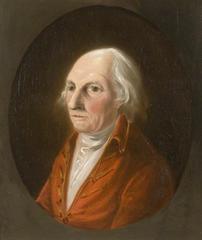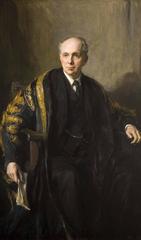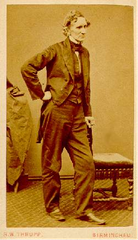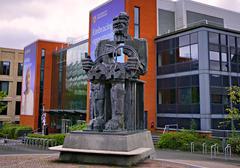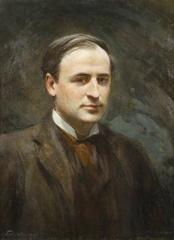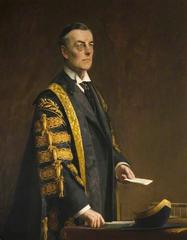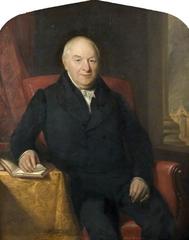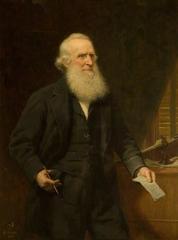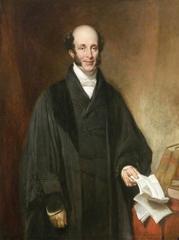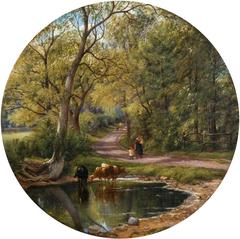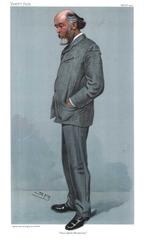
University of Birmingham Visiting Guide: United Kingdom—Tickets, Hours, and Attractions
Date: 14/06/2025
Introduction: History, Cultural Significance, and What to Expect
The University of Birmingham is one of the UK’s most distinguished civic universities, recognized for its historic contributions to education, iconic architecture, and a vibrant cultural scene. Officially founded in 1900 as the first “redbrick” university in England, it has played a pioneering role in making higher education accessible to people from all backgrounds. Its roots stretch back to the 18th-century medical seminars and Mason Science College, underscoring a long-standing commitment to scientific and medical advancement (University of Birmingham History and Heritage).
Set on a 672-acre Edgbaston campus—among the largest in the UK—visitors can admire landmarks like the world’s tallest free-standing clock tower, “Old Joe,” and the Barber Institute of Fine Arts, which houses masterpieces by Monet, Picasso, and Van Gogh (Facts.net; PlanetWare). With its blend of historic and modern buildings, expansive green spaces, and renowned museums, the campus offers a rich visitor experience.
This guide details visiting hours, ticketing, accessibility, travel advice, and local attractions. Whether you’re interested in guided tours—including visits to WWII tunnels—or in attending concerts and exhibitions, this resource ensures a rewarding and seamless visit (University of Birmingham Campus Tours; Conferences at Birmingham).
Table of Contents
- Historical Overview and Significance
- Architectural and Campus Highlights
- Academic Achievements and Research Impact
- Visiting the University: Practical Information
- Social and Cultural Significance
- Legacy and Continuing Influence
- Unique Features and Visitor Insights
- FAQ
- Practical Tips for Visitors
- Events and Activities
- Notable Nearby Attractions
Historical Overview and Significance
Foundations and Early Development
The University’s origins date to the late 18th century, beginning with medical education seminars led by John Tomlinson in 1767–68 (University of Birmingham History and Heritage). The establishment of Mason Science College in 1875 by Josiah Mason marked a significant step toward accessible scientific and medical education. By 1892, Mason College absorbed the Birmingham Medical School, further consolidating its academic foundations (k12academics.com).
The Civic University Movement and Royal Charter
Granted a Royal Charter by Queen Victoria in 1900, the University of Birmingham became the first English civic university to break away from religious or social restrictions in admissions. Joseph Chamberlain, the university’s first Chancellor, envisioned an institution aligned with the needs of Birmingham’s diverse population and local industries (University of Birmingham History and Heritage; Facts.net).
Architectural and Campus Highlights
Key Landmarks
- Old Joe (Joseph Chamberlain Memorial Clock Tower): At 100 meters tall, Old Joe is the world’s tallest free-standing clock tower and an enduring symbol of the university (Facts.net).
- Barber Institute of Fine Arts: Opened in 1939, this Grade I listed gallery features works by Van Gogh, Monet, and Picasso, and hosts regular concerts and exhibitions (PlanetWare).
- Aston Webb Building: Designed by Sir Aston Webb, this Grade II listed building houses the domed Great Hall, a central venue for graduations and events (Aston Webb Building).
- Lapworth Museum of Geology: Located in the Aston Webb Building, the museum showcases over 250,000 geological specimens and is open to the public (Lapworth Museum).
- Winterbourne House and Garden: A short walk from campus, this Edwardian house and seven-acre garden is renowned for its horticultural collections (Winterbourne House).
Academic Achievements and Research Impact
The University of Birmingham pioneered the campus-based university model and was the first in the UK to include a medical school and dentistry degrees (Times Higher Education). Major achievements include:
- Development of the pacemaker and plastic heart valves
- Pioneering allergy vaccines and UK’s first clinical trials for the contraceptive pill
- Synthesis of artificial Vitamin C and development of the cavity magnetron (crucial for radar and microwaves)
- Eight Nobel Laureates among staff and alumni
Today, the university leads research in nanotechnology, gene therapy, virtual reality, and robotics (University of Birmingham Academic History).
Visiting the University: Practical Information
Visiting Hours and Ticket Information
- Campus: Open to visitors daily, typically from 8:00 AM to 6:00 PM.
- Barber Institute of Fine Arts: Tuesday–Sunday, 10:00 AM–5:00 PM; closed Mondays.
- Lapworth Museum of Geology: Tuesday–Saturday, 10:00 AM–5:00 PM; closed Sundays and Mondays.
- Winterbourne House and Garden: Tuesday–Sunday, 11:00 AM–4:30 PM; closed Mondays. Admission fees apply except for some open days.
- Guided Tours: Book in advance on the university website for historical and architectural tours, including WWII tunnels (Campus Tours).
Entrance Fees
- Entry to the campus, Barber Institute, and Lapworth Museum is free.
- Winterbourne House and special exhibitions/concerts may require paid tickets; check official sites for details.
Accessibility
- Step-free access, accessible toilets, and clear signage across campus (Accessibility)
- Blue Badge parking and accessible accommodation at Edgbaston Park Hotel (Edgbaston Park Hotel)
- Downloadable mobility maps and support available via visitor services
Travel Tips and Parking
- By Train: The on-campus University (Birmingham) railway station is just 7 minutes from Birmingham New Street (Birmingham Mail).
- By Bus: Routes 61, 63, X20, X21, X22 serve the campus.
- By Car: Paid parking at North East Multi-storey Car Park (Pritchatts Road, B15 2SA); check for Blue Badge spaces and EV charging (Travelling by Car).
- By Bicycle: Cycle-friendly routes and bike racks are available.
Social and Cultural Significance
From its foundation, the University of Birmingham has championed inclusivity, admitting students regardless of background. Today, it hosts a diverse student body from over 150 countries (Facts.net). The campus is a cultural hub, with frequent public events, exhibitions, and performances (PlanetWare).
Green spaces like the Green Heart add to the campus’s appeal and support Birmingham’s reputation as one of the UK’s greenest cities (Times Higher Education).
Legacy and Continuing Influence
Notable alumni include former British Prime Ministers Stanley Baldwin and Neville Chamberlain. The university maintains strong local and international partnerships and continues to expand its global reach with campuses abroad (University of Birmingham History and Heritage).
Unique Features and Visitor Insights
Explore the WWII air raid tunnels beneath campus on special guided tours (Facts.net). Monthly farmers’ markets, open days, and a full calendar of music and art events provide rich opportunities for immersive experiences.
FAQ
Q: What are the main visiting hours?
A: Outdoor campus areas are open from dawn to dusk; museums and galleries operate Tuesday–Sunday, 10 AM–5 PM. Always check official websites for updates.
Q: Is there an entrance fee?
A: Most areas, including museums, are free. Winterbourne House and some events require tickets.
Q: Is the campus accessible for all visitors?
A: Yes, with extensive step-free access, mobility maps, and accessible facilities.
Q: How do I get there?
A: By train to University (Birmingham) station, by bus, car (paid parking), or bicycle.
Q: Can I attend university events as a visitor?
A: Many concerts, exhibitions, and markets are open to the public. See the events calendar.
Practical Tips for Visitors
- Plan ahead: Review campus maps and event schedules.
- Use public transport: The campus is well connected by train and bus; parking fills quickly on busy days.
- Check accessibility resources: Download mobility maps and arrange support if needed.
- Sample food and drink: The campus offers numerous cafés and restaurants with dietary options.
- Explore nearby: Don’t miss attractions like Birmingham Botanical Gardens, Winterbourne House, and the Jewellery Quarter.
Events and Activities
The university celebrates its 125th anniversary in 2025 with special events, concerts, and festivals (University of Birmingham Events). Other highlights include heritage building tours, artisan markets, and major sports events like the UK 10,000m Championships (British Athletics). For a full listing, visit the university’s events page.
Notable Nearby Attractions
- Birmingham Canals: A scenic walk links the campus to the city centre (Visit Birmingham).
- Edgbaston and Selly Oak: Explore historic architecture and vibrant student life.
- Winterbourne House and Garden: Edwardian house and botanical gardens just minutes from the main campus.
Essential Visitor Facilities
- Restrooms: Available in main buildings, including the Main Library and Barber Institute.
- Wi-Fi: Free guest Wi-Fi (“UoB Guest”) throughout campus.
- Accessibility: Step-free routes, lifts, Blue Badge parking, and accessible accommodation.
- Information Points: Found in the Aston Webb Building and Main Library.
Food and Drink
Choose from over 30 outlets, including independent cafés, restaurants, and bars. Vegetarian, vegan, halal, and gluten-free options are widely available (Conferences at Birmingham).
Accommodation
Stay at the on-campus Edgbaston Park Hotel and Conference Centre, or explore hotel options in Birmingham city centre.
Sustainable and Responsible Visiting
The university is committed to sustainability; use recycling bins, refill water bottles, and consider public transport or cycling. Please respect study areas and help maintain a welcoming environment for all.
Useful Contacts and Resources
- Main Switchboard: +44 (0)121 414 3344 (University of Birmingham)
- Visitor Information: Conferences at Birmingham
- Events Calendar: University of Birmingham Events
- Transport Information: National Rail, West Midlands Buses
Summary and Recommendations
Visiting the University of Birmingham is a rewarding experience, offering a blend of educational heritage, world-class art, green spaces, and a lively calendar of events. Accessible, easy to navigate, and friendly to all, the campus is perfect for history enthusiasts, prospective students, and tourists alike. Plan ahead, check event listings, and make use of public transport for the best experience.
Enhance your visit by downloading the Audiala app for campus maps, guided tours, and up-to-date event information. For more insights, explore related articles on Birmingham’s historical sites and follow university channels for the latest visitor news.
References and Official Links
- University of Birmingham History and Heritage
- Aston Webb Building
- University of Birmingham Campus Tours
- Conferences at Birmingham
- Facts.net – 13 Enigmatic Facts About University of Birmingham
- PlanetWare – Tourist Attractions in Birmingham
- Times Higher Education – University of Birmingham Profile
- British Athletics – UK 10,000m Championships at Birmingham
- Visit Birmingham – Birmingham Canal Network


